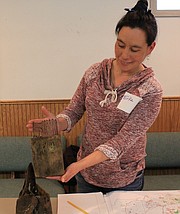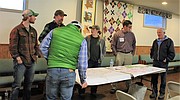Huge forest project values public comment Large crowd turns out to learn about, discuss Redd Bull project south of St. Regis
A slide came up on a screen at a recent public meeting, showing a blue triangle that read, “Proposal Development – Collaboration” on one side; “Environmental Analysis – Scoping” on another side; and “Implementation” on the third side.
The slide was part of a Forest Service presentation for Redd Bull. A nearly 86,000 acre project in Mineral County. Almost 95 percent of it is national forest land, 170 acres is state and 3,739 acres are privately owned.
What makes this meeting unique is the overwhelming public interest in the project. Nearly 40 people attended the meeting which was held in at the St. Regis Community Center on Mar. 29 from 6 to 8 p.m.
“You continue to show your passion for management of public lands,” said Superior District Ranger, Carol Johnson. “When you take an area the size of Redd Bull and look at all the projects, whether it’s commercial (timber) harvesting, road work, improving fisheries, or recreation, this project should create a lot of economy. Especially when you look at all the different things it involves.”
Currently the project is in the “Proposal Development/Collab-oration” phase of the triangle. The public is being asked to participate and comment on the various aspects of the project. Forest Service representatives discussed watershed, wildlife, vegetation, fire management, recreation, and timber harvest opportunities and asked for input.
“My staff and I were pleased to hear many great ideas, questions and positive feedback and that you want the project to stay on track with the timeline,” said Johnson after the meeting. “I am committed to continue to involve the public early in the process and value your thoughts and ideas. Your interest and participation is very important.”
Oftentimes with these types of projects, the public doesn’t have the opportunity to give their input until the scoping phase. For Redd Bull, scoping letters will be tentatively be sent out next February.
“We’re trying to get comments early in the process rather than at the end when we can’t do much,” said Johnson. She is also planning on holding future meetings and field trips to the area for further public input. Last fall a group of nearly 50 people took a tour of Redd Bull.
The point of the meetings are to continue to gather comments. Representatives each had a map at tables in the room and after their presentation, participants had the opportunity to visit with them.
“When you improve the ability for people to come and use the forest, that’s huge for us,” commented local resident, Carole Young.
One example are the roads. Questions about how much they are used and for what purpose is important to know, and the local residents have first-hand knowledge. They know a lot about the area and their use.
Redd Bull expands south of St. Regis and encompasses 580 mapped roads. When assessing the area, forest service personnel look at timber management, fire and public access and impacts on aquatic and wildlife. Brian Story, a transportation planner, discussed the roads and said they had looked at the possibility of paving Little Joe. However, they did not get the funding needed to study the benefit of paving. Resurfacing the road is still on the list for consideration, he said.
Carly Aniballi, an agriculturalist, discussed the various trees, including Ponderosa Pine and Western Larch, timber production, and watersheds. Bull trout, which are on the endangered species list, are in that area and have an emphasis on how the area will be managed. She also talked about fire management and hazardous fuel reduction plans. The area seems to be susceptible to wildfires, with 197 starts since 1980. However, most did not grow past five acres.
Wildlife biologist, Dave Wroboleski, discussed grizzly bears and Canadian Lynx, both threatened species and their impact on the project. Though grizzlies aren’t prevalent in the area, they do move through it. This is also the case with the lynx. He said they will need to access the effects of the project on these species, but it will not factor into the project design. Other wildlife considerations will be elk herds and the need to improve both summer and winter range. As well as wolverines and fishers, a small weasel type animal.
Heather Burman, who took over Beth Kennedy’s position as resource assistant, was there to discuss recreational opportunities. She just moved into the area from New Mexico and so public comment will be particularly important for her since she is unfamiliar with the area.
Erika Karuzas, an archeologist, talked about historical sites often found in project areas. Forgotten graves, Indian burial sites, old homesteader cabins, all have significance to the area. If there is a find with remnants intact, they would like to try and preserve it. However, if there isn’t much left, they don’t try to protect the site.
Currently approximately 48 sites have been recorded and she said there are probably about 50 more. One they found contained a couple of walls from an old miner’s cabin. She said it had two windows, which is unusual for these types of cabins. Nearby, they found a rusty berry picker. From these items, she assessed that there must have been a woman living in the cabin.
“Miners don’t usually care about having windows in the cabin,” she said, “but women do. Plus, the berry picker indicates she probably made preserves.”
Other speakers for the evening were Jon Hanson, a fisheries biologist; Dustin Walters, a hydrologist; and Laurie Cotter, a fuel management specialists.





